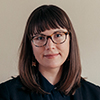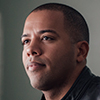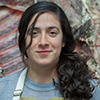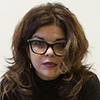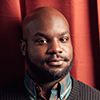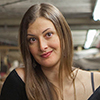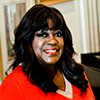



Nudd, 38, is a fine artist whose hallucinatory, sometimes grotesque drawings, paintings, and videos have been exhibited locally at Western Exhibitions, Hyde Park Art Center, and the Museum of Contemporary Art, with solo shows around the nation and as far afield as the Bourouina Gallery in Berlin. He teaches at Columbia College and the School of the Art Institute, and since 2001 he has been an art instructor at Cicero East Elementary School.
Interview by J.R. Jones
Photos by Alison Green

I was stuck in this junior high school that was a typical middle-American, totally white-bread suburban milieu. I spent a lot of time goofing around, and I didn’t have a huge amount of respect for the teachers. I wasn’t the kind of kid that would go around smashing windows out of cars, but I was very hard to motivate. So I started to draw, and I became very well known in my junior high, just lampooning my peers, kind of mean-spirited drawings, with this emphasis on horror and violence and nudity. If I was drawing at the lunch table, people would gather round. That was my first little taste of the power of art as a subversive force.
[John Carpenter’s The Thing is] a great example of art that I’m repelled by but keep coming back to. Like, Cindy Sherman’s photographs are really difficult to look at, but you just have to figure out what’s going on. The Thing was this movie that really terrified me. [What] really stuck with me was the perversion of the human form. I watch it a couple of times every year still.

I had a huge advantage in that my parents pretty much let me do whatever I wanted; they were really supportive. My older brother James—he’s about a year older than me—expressed this interest in art. When I was in seventh, eighth grade, I didn’t really consider that you could get into it as a career. At Lincoln-Way High School, he enrolled in some of the art classes; I remember seeing what he was bringing home, and I was really impressed. It let off this little spark that made me want to get into it.
My parents weren’t into art, but they did take me to the Art Institute. They would take me to all the retrospective shows: Max Ernst, René Magritte, Ivan Albright. In ’91 or ’92, I started taking Saturday classes at the Art Institute, in the young artists’ program. By the time I went to college, I knew the progression of modern art and a handful of contemporary artists as well. . . . We were on vacation visiting some family up in Connecticut, and we went to the 1997 Whitney Biennial. If there ever was a moment where I knew I belonged in art, it would probably be that. It was a pretty powerful show.

You go to [art history] class and you learn about Cézanne. And then you learn about Matisse and Picasso. And then after Picasso you start getting into what comes next, and everything’s compartmentalized. [But] in the world, it’s more amorphous, and it’s more difficult to conveniently parcel away in little isms. When you get out [of art history class], you’re supposed to be making things. And then you’ve got this whole other world that consists of The Thing and Iron Maiden album covers and Garbage Pail Kids and Wacky Packages and Robert Crumb comics.

A lot of those distinctions are starting to crumble. I teach comics at [School of the Art Institute], and I remember at parent weekend, I was like, “All that garbage that we bought in drugstores I can teach at a college level now, because this was pretty interesting stuff.” I had this mental hierarchy of what was more important—like the world of painting, since it belongs in these rigid institutions that are 500 years old, it must be more important than something that comes out of a newspaper. I’ve reexamined that whole idea of authority, particularly in the last couple years.


Painters are raked over the coals more than anyone else, because there’s such a tremendous history weighing down on them. Whereas when you’re dealing with new media or photography or installation art, there’s not as much ammunition you can use against somebody. When I made videos, my reasons were pretty reactionary: “I’m gonna buy a camcorder off of Ebay, make some sculptures, put a bunch of gunk in them and make a video painting.” The irony was they were received really well! [Laughs] When I first got out of grad school, everywhere you went there would be one playing in a gallery somewhere. But then I learned that it wasn’t really gonna go anywhere, and I started getting back to what I really wanted to focus on: painting and drawing.

I got a chance to teach a few elementary art classes in college, and I really became interested in the art of very young kids. It was a magnificent experience, having a classroom full of small kids—six, seven, eight, nine years old. It’s really magical. At the same time I was taking studio art classes, which were worlds apart. I always kept those worlds separate until maybe five or six years ago they just started to blend together, to inform one another. I’ve been doing this shadow-puppet theater with some of the kids. It’s an art form that I’ve never really known about. And that has led to me projecting more images in my studio. So there’s practical things like that, but there’s also this creative energy that I try to direct and harness. It’s been a real joy to witness.




